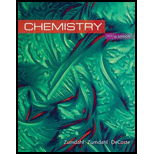
Concept explainers
A chemical “breathalyzer” test works because ethanol in the breath is oxidized by the dichromate ion (orange) to form acetic acid and chromium(III) ion (green). The balanced reaction is
Interpretation: The mole percent of alcohol of the breath is to be calculated.
Concept introduction: Number of moles is defined as the mass divided by the molecular of the element. Mole percent is calculated by knowing the mass and mole fractions of any element.
To determine: The mole percent of alcohol of the breath.
Answer to Problem 171CP
Answer
The mole percent of alcohol of the breath is
Explanation of Solution
Explanation
The number of moles is calculated by the formula,
Given,
Therefore, moles of
Substitute the value of the given mass and the molar mass, to calculate the number of moles of
The given reaction is,
According to the stated reaction, 3 moles of alcohol react with 2 moles of
Therefore,
The idea gas equation is,
Given,
The volume of the breath (V) is
Rearrange the ideal gas equation to calculate the number of moles.
Substitute the value of
Therefore,
The mole percent of alcohol of the breath is calculated as,
Conclusion
The mole percent of alcohol of the breath is
Want to see more full solutions like this?
Chapter 22 Solutions
Chemistry
- Complete and balance the following combustion reactions. Assume that each hydrocarbon is converted completely to carbon dioxide and water. (a) Propane + O2 (b) Octane + O2 (c) Cyclohexane + O2 (d) 2-Methylpentane + O2arrow_forwardWrite the chemical formulas for the products formed when each of the following hydrocarbons undergoes complete combustion. a. CH4 b. C4H10 c. C4H6 d. C6H6arrow_forwardThe product(s) that can be formed in the given reaction is/are Br, H,0 NaCl Br Br Br CI Brarrow_forward
- Consider the products of the following reaction. 塩基=base 加熱=heatingarrow_forwardYou are working in a forensic lab and are given a blood sample from a suspected drunk driver and asked to determine the person's blood alcohol level. The legal limit is 0.08% by mass in most states. You use the following reaction in your determination, assuming only the ethanol (C2H5OH) in the blood sample will react with the dichromate.16H+(aq) + 2Cr2O72−(aq) + C2H5OH(l) 4Cr3+(aq) + 11H2(l) + 2CO2(g) If 14.6 mL of 0.10 M K2Cr2O7 are needed to react completely with 28 g of blood, what is the blood alcohol level of the driver?arrow_forwardNO, 3 NaOH 100°C NO2arrow_forward
- Cyclohexanol is oxidized with acidified sodium dichromate to form cyclohexanone. Twenty gram (20g) of cyclohexanol is used and 12.5 g of product is obtained in this reaction. Calculate the percentage of yield of product in this reaction. * он | • Cr2o? + 8H* 3 +7 H,0 + 2 Cr3+arrow_forwardThe breathalyzer test utilizes the reaction between the dichromate ion and ethanol to produce acetic acid. Balanced equation for this process is given below. How much acetic acid can be produced from a mixture containing an excess of dichromate ion and 5.66 x 10g of ethanol? 16H* + 2Cr,0,2- + 3CH,CH,OH – 3CH3COOH + 4Cr** + 11H,0 Enter your answer in the provided box. g CH3COOH 7 of 10 Next > < Prevarrow_forwardPredict the products of the following reaction. If no reaction will occur, use the NO REACTION button. Be sure your chemical equation is balanced! CH, (CH₂) CH₂(g) + O₂(g) → 2 A 00 X NO REACTION 5arrow_forward
- Course name: College Chemistry. Lab The answer must be handwritten and step by step a clear explanation. Course code: 141 1. When yeast is added to a solution of glucose or fructose, the sugars are said to undergo fermentation and ethyl alcohol is produced. C6H1206(aq) →→→→C₂H5OH(aq) + CO₂(g) This is the reaction by which wines are produced from grape juice. Calculate the mole of ethyl alcohol produced when 1.75 mol glucose molecules undergo this reaction. (2 marks)arrow_forwardDecomposition Reactions Carbon Reduction Reactions 2 Ag₂O(s)→ 4 Ag(s) + O₂(g) 2 MgO(s) → 2 Mg(s) + O₂(g) 2 Al₂O3(s) → 4 Al(s) + 3 O₂(g) 2 Fe₂O3(s)- 4 Fe(s) + 3 O₂(g) 2 HgO(s) → 2 Hg(1) + O₂(g) 2 Cr₂O3(s) → 4 Cr(s) + 3 O₂(g) Temperature Clear Graph 300 K AH° AS° (kJ) (J/K.mol) +62.2 +132.7 +1202.4 +216.7 +3351.4 +546.8 +1648.4 +551.5 +181.7 +2269.4 +286.8 +548.4 AG°(kJ) -1000 0 1000 2000 3000 300 Temperature (K) 2000 The metals Mg and Al, like most metals in groups 1A, 2A, and 3A of the periodic table, cannot be obtained by chemical reduction with carbon at reasonable temperatures. What process is used to obtain these metals from their ores?arrow_forwardHi! I'm a college student and i need your help in answering my chemistry subject. Please do help me and I promise to rate it helpful. Please put an understandable or clearer solutions and if possible you can put a brief explanation. Thank you so much and God bless! Nitrogen oxide is oxidized ina air to give brown nitrogen dioxide. If you have 2.2 moles of NO, 2NO(g) + O2(g) → 2NO2(g), therefore, you need _____ moles of O2 for complete reaction and produce _____ moles of NO2arrow_forward
 General, Organic, and Biological ChemistryChemistryISBN:9781285853918Author:H. Stephen StokerPublisher:Cengage Learning
General, Organic, and Biological ChemistryChemistryISBN:9781285853918Author:H. Stephen StokerPublisher:Cengage Learning Organic ChemistryChemistryISBN:9781305580350Author:William H. Brown, Brent L. Iverson, Eric Anslyn, Christopher S. FootePublisher:Cengage Learning
Organic ChemistryChemistryISBN:9781305580350Author:William H. Brown, Brent L. Iverson, Eric Anslyn, Christopher S. FootePublisher:Cengage Learning Chemistry & Chemical ReactivityChemistryISBN:9781337399074Author:John C. Kotz, Paul M. Treichel, John Townsend, David TreichelPublisher:Cengage Learning
Chemistry & Chemical ReactivityChemistryISBN:9781337399074Author:John C. Kotz, Paul M. Treichel, John Townsend, David TreichelPublisher:Cengage Learning Chemistry & Chemical ReactivityChemistryISBN:9781133949640Author:John C. Kotz, Paul M. Treichel, John Townsend, David TreichelPublisher:Cengage Learning
Chemistry & Chemical ReactivityChemistryISBN:9781133949640Author:John C. Kotz, Paul M. Treichel, John Townsend, David TreichelPublisher:Cengage Learning



